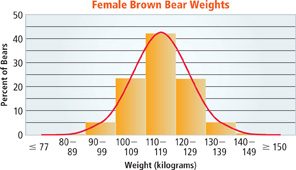Sometimes an extraordinary factor affects data that would otherwise be normally distributed. A coin, for example, may be somehow weighted unevenly so that heads tends to come up more frequently than tails. In such a case, the data set could have a distribution that is skewed, an asymmetric curve where one end stretches out further than the other end.
 Problem 1 Analyzing Normally Distributed Data
Problem 1 Analyzing Normally Distributed Data
Zoology The bar graph gives the weights of a population of female brown bears. The red curve shows how the weights are normally distributed about the mean, 115 kg. Approximately what percent of female brown bears weigh between 100 and 129 kg?
Plan
How do you find this percent?
The percents for each bar are based on the same sample population of bears. You can add the percents.
Estimate and add the percents for the intervals 100–109, 110–119, and 120–129.
23 + 42 + 23 = 88
About 88% of female brown bears weigh between 100 and 129 kg.
✓ Got It?
-
- Approximately what percent of female brown bears in Problem 1 weigh less than 120 kg?
- The standard deviation in the weights of female brown bears is about 10 kg. Approximately what percent of female brown bears have weights that are within 1.5 standard deviations of the mean?
When data are normally distributed, you can sketch the graph of the distribution using the fact that a normal curve has a symmetric bell shape.
Table of Contents
- 5-1 Polynomial Functions
- 5-2 Polynomials, Linear Factors, and Zeros
- 5-3 Solving Polynomial Equations
- 5-4 Dividing Polynomials
- 5-5 Theorems About Roots of Polynomial Equations
- 5-6 The Fundamental Theorem of Algebra
- 5-7 The Binomial Theorem
- 5-8 Polynomial Models in the Real World
- 5-9 Transforming Polynomial Functions






